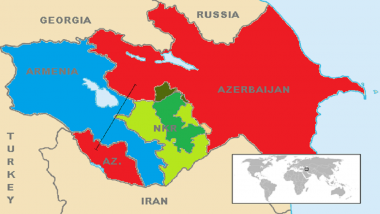Azerbaijan and Armenia, the two Caucasian neighbours on collision path since the past three decades, are involved in a precarious military face-off once again. The fresh flare-up was reported on Sunday, after Yerevan claimed that it downed two defence helicopters of Baku in response to the "unprovoked shelling" in Nagorno-Karabakh region. Since the wee hours of yesterday, several soldiers and civilians on both sides have reportedly been killed.
Why Azerbaijan, Armenia Are On Edge of Full-Blown War
The Armenia-Azerbaijan clash, though based on a historical rivalry, reflects the tensions that remains in eastern Europe region - where the Muslim-Christian divide is once again playing a major role in shaping geopolitical rows. The violent face-off comes amid brewing tensions between Turkey and Greece - the two countries backing Baku and Yerevan, respectively.
At Heart of Military Confrontation is Nagorno-Karabakh Dispute
Nagorno-Karabakh, located close to Armenia, is break-away province of Azerbaijan. After the fall of Soviet Union in 1991, it was declared as a de-facto sovereign territory and ruled by a separate government. Since, then it is also referred to as the Republic of Artsakh. Legally, however, the region fall under Azerbaijan.
For six years, from 1988 to 1994, the Armenian and Azerbaijani forces clashed over the territory of Nagorno-Karabakh. A ceasefire agreement was inked in 1994, after the intervention of France, the United States and Russia.
Why Nagorno-Karabakh Broke Away From Azerbaijan
Azerbaijan is a predominantly Muslim country, with Nagorno-Karabakh being the only province with a Christian majority. As per the 2015 census in Artsakh, the population of roughly 145,000 comprised of 144,683 ethnic Armenians Christians who follow the Armenian Apostolic Church. The remaining few hundreds were identified as Russians.
Why The Region is Crucial to Hold on For Azerbaijan
Spread over an area of 11,458 square kilometres, the breakaway province is crucial for Azerbaijan to continue its oil pipeline projects in an unabated manner. The oil and natural gas rich country, which reaps the benefits of being closest to the Caspian Sea, currently operates two key oil pipelines - from Baku to Ceyhan in Turkey and from Baku to Supsa in Georgia.
With oil being the primary source of revenue for Azerbaijan, the country wants to maintain complete political control over Nagorno-Karabakh, as the breakaway province may disrupt the setting up of future oil pipelines from the Caspian Sea coast to the Mediterranean region.
Brief History of the Military Face-Offs
1988-1994: This was the most fatal phase of the clashes so far, leading to an estimated loss of 28,000-38,000 lives. The numbers included vast number of civilians as both sides accused each other of conducting pogroms and ethnic cleansing campaigns.
2008-2016: In the flare-ups reported in the eight-year period, an estimated death of over 1,300 persons were recorded. This included 214 soldiers and 16 civilians of Armenia and ethnic Armenians in Nagorno-Karabakh. The bulk of the fatalities were faced by Azerbaijan, whose 1,008 soldiers and more than 90 civilians were killed.
2018-Present: In five major clashes reported in 2018, nine casualties were reported on the Armenian side. This year, the violent face-offs were reported from July. 13 Azeris, including one civilian and 12 soldiers were killed in clashes near Tavush. Five Armenians were also reported dead. In clashes reported since September 16 in Nagorno-Karabakh, at least 23 fatalities - heaviest in last fours years - have been recorded.
(The above story first appeared on LatestLY on Sep 28, 2020 04:35 PM IST. For more news and updates on politics, world, sports, entertainment and lifestyle, log on to our website latestly.com).













 Quickly
Quickly





















